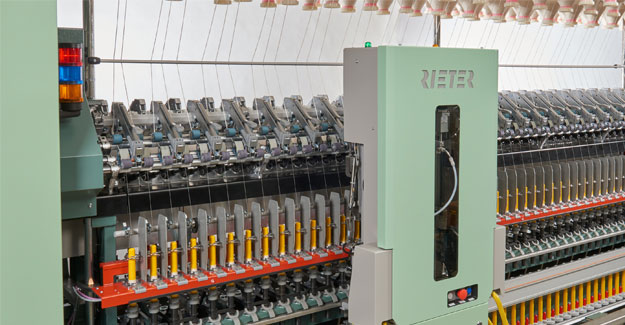
Rieter Ring and Compact Spinning Machines Impress With Unrivaled Economy
Significant energy savings with the G 37 and the K 47
[caption id="attachment_20363" align="alignleft" width="300"]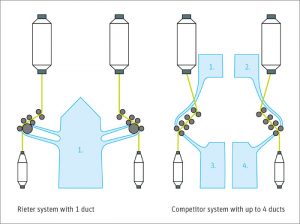 Rieter one-duct system for ring and compact spinning lowers air speed and energy consumption. (Fig.1)[/caption]
The ring spinning machine G 37 and the compact spinning machine K47 are the most efficient machines for high quality ring and compact yarns. In terms of economy, both machines have an outstanding advantage compared to competition – the unique suction system. Only one duct for pneumafil (suction of ends down fibres) and compacting suction reduces the energy consumption. This energy is needed to generate the necessary vacuum up to the last spinning position (Fig. 1). The large cross-section of the suction duct lowers the air speed and reduces the air resistance.
The double-sided suction on long machines creates additional energy savings by further reducing the energy required to generate the necessary vacuum. Compared to a single-sided suction system, the same air volume can be transported using less energy. Together with the air guide element Detect, the K 47 can save up to 80% compacting energy compared to other solutions.
IE4 main motor drive, 4-spindle tape drive and LENA spindle
In ring and compact yarn production, 50to 60% of the energy costs in the whole spinning process arise on the end spinning machine. For this reason, Rieter is particularly investing in energy-efficient technologies and developments in this area.
More than 80% of the energy of the end spinning machine is used for the spindle drive. Here, energy savings can be achieved with the extremely efficient IE4 main motor drives which were developed for high speeds. The motor can also be used profitably on machines with fewer spindles and low speeds due to its permanent magnetic functioning.
[caption id="attachment_20364" align="alignright" width="300"]
Rieter one-duct system for ring and compact spinning lowers air speed and energy consumption. (Fig.1)[/caption]
The ring spinning machine G 37 and the compact spinning machine K47 are the most efficient machines for high quality ring and compact yarns. In terms of economy, both machines have an outstanding advantage compared to competition – the unique suction system. Only one duct for pneumafil (suction of ends down fibres) and compacting suction reduces the energy consumption. This energy is needed to generate the necessary vacuum up to the last spinning position (Fig. 1). The large cross-section of the suction duct lowers the air speed and reduces the air resistance.
The double-sided suction on long machines creates additional energy savings by further reducing the energy required to generate the necessary vacuum. Compared to a single-sided suction system, the same air volume can be transported using less energy. Together with the air guide element Detect, the K 47 can save up to 80% compacting energy compared to other solutions.
IE4 main motor drive, 4-spindle tape drive and LENA spindle
In ring and compact yarn production, 50to 60% of the energy costs in the whole spinning process arise on the end spinning machine. For this reason, Rieter is particularly investing in energy-efficient technologies and developments in this area.
More than 80% of the energy of the end spinning machine is used for the spindle drive. Here, energy savings can be achieved with the extremely efficient IE4 main motor drives which were developed for high speeds. The motor can also be used profitably on machines with fewer spindles and low speeds due to its permanent magnetic functioning.
[caption id="attachment_20364" align="alignright" width="300"]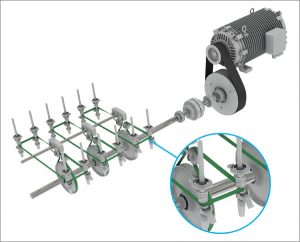 Optimal power transmission due to the 90° enlacement. (Fig 2.)[/caption]
In addition, the proven Rieter 4-spindle tape drive with only one large drive motor shows great advantages (Fig. 2). The 4-spindle tape drive is energy-efficient, easy to handle and operates without failure. The low contact pressure due to only 90° enlacement guarantees low energy consumption. Furthermore, the LENA spindle reduces the overall energy consumption of the machine by up to 4% and is recommended for yarn counts Ne 28 and finer.
Low total energy consumption
The following graphic breaks down the total energy consumption of the compact-spinning machine K 47 (Fig. 3). It shows that with the K 47 less energy is required for the spindle drive, the drafting system drive and the total suction compared to the competitor.
[caption id="attachment_20365" align="alignnone" width="720"]
Optimal power transmission due to the 90° enlacement. (Fig 2.)[/caption]
In addition, the proven Rieter 4-spindle tape drive with only one large drive motor shows great advantages (Fig. 2). The 4-spindle tape drive is energy-efficient, easy to handle and operates without failure. The low contact pressure due to only 90° enlacement guarantees low energy consumption. Furthermore, the LENA spindle reduces the overall energy consumption of the machine by up to 4% and is recommended for yarn counts Ne 28 and finer.
Low total energy consumption
The following graphic breaks down the total energy consumption of the compact-spinning machine K 47 (Fig. 3). It shows that with the K 47 less energy is required for the spindle drive, the drafting system drive and the total suction compared to the competitor.
[caption id="attachment_20365" align="alignnone" width="720"]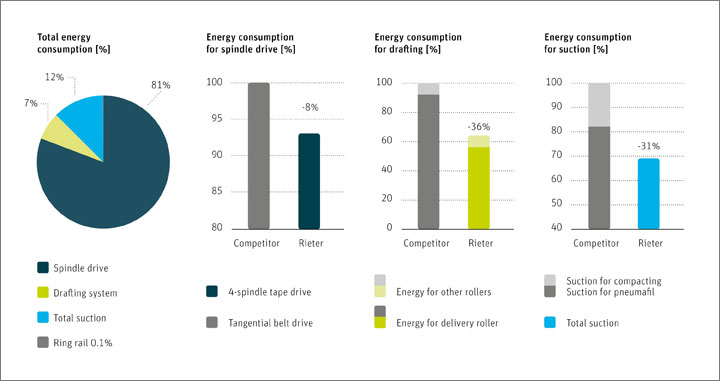 Rieter K 47machine with tangential belt and apron system: Ne 30, 775 T/m,19 500 rpm, 1 824 spindles (Fig. 4)[/caption]
Short machine changeover time
In terms of efficiency, an outstanding advantage of the G 37 and K 47 is the easy yarn setting. The semi-electronic drafting system allows a fast gear change for yarn count settings.
Parameters such as yarn twist and twist direction can be simply set by fingertip on the operating unit. There is no need to change gears or make any other mechanical adjustments which leads to less work for operating personnel.
The machine changeover time for a complete yarn parameter change including yarn count, twist and Z or S twist direction is reduced to 65 minutes, compared to 145 minutes for a competitor’s mechanical system. The spinning of small batches becomes much more economical.
Minimal personnel deployment
ROBOspin is the first fully automated piecing robot for ring spinning machines and increases productivity significantly. One robot per machine side repairs ends down that occur during doffing or while the machine is running. The robot travels directly to the affected spinning position and repairs the ends down in the shortest time possible (Fig. 4).
As a result, the complete piecing cycle runs fully automatically – from finding the yarn on the cops to placing the yarn in the traveler, in the yarn guide element and behind the delivery roller. The robot receives the required information from the integrated individual spinning monitoring system ISM premium.
The ISM basic is a standard on all Rieter ring and compact-spinning machines. LEDs at each spinning position show the running properties of each spinning position and indicate to the operator in which area of the machine ends down must be remedied. The targeted operator guidance increases the efficiency of the personnel.
The optional ISM premium provides even more efficiency. It has an LED at each section and additional signal lamps at the head stock and end stock of the machine. They light up as soon as the defined limit for ends down is exceeded and reduce the walking distances for the operator. With two different LEDs at every spinning position, ISM premium indicates the speed deviations of each individual spindle, the exact spinning position for quality feedback from the winding machine as well as roving stop in case of ends down.
These and many other features make the new Rieter ring and compact-spinning machines the perfect fit for spinners who count on high efficiency while saving costs through low energy consumption. Find out more on www.rieter.com
Rieter K 47machine with tangential belt and apron system: Ne 30, 775 T/m,19 500 rpm, 1 824 spindles (Fig. 4)[/caption]
Short machine changeover time
In terms of efficiency, an outstanding advantage of the G 37 and K 47 is the easy yarn setting. The semi-electronic drafting system allows a fast gear change for yarn count settings.
Parameters such as yarn twist and twist direction can be simply set by fingertip on the operating unit. There is no need to change gears or make any other mechanical adjustments which leads to less work for operating personnel.
The machine changeover time for a complete yarn parameter change including yarn count, twist and Z or S twist direction is reduced to 65 minutes, compared to 145 minutes for a competitor’s mechanical system. The spinning of small batches becomes much more economical.
Minimal personnel deployment
ROBOspin is the first fully automated piecing robot for ring spinning machines and increases productivity significantly. One robot per machine side repairs ends down that occur during doffing or while the machine is running. The robot travels directly to the affected spinning position and repairs the ends down in the shortest time possible (Fig. 4).
As a result, the complete piecing cycle runs fully automatically – from finding the yarn on the cops to placing the yarn in the traveler, in the yarn guide element and behind the delivery roller. The robot receives the required information from the integrated individual spinning monitoring system ISM premium.
The ISM basic is a standard on all Rieter ring and compact-spinning machines. LEDs at each spinning position show the running properties of each spinning position and indicate to the operator in which area of the machine ends down must be remedied. The targeted operator guidance increases the efficiency of the personnel.
The optional ISM premium provides even more efficiency. It has an LED at each section and additional signal lamps at the head stock and end stock of the machine. They light up as soon as the defined limit for ends down is exceeded and reduce the walking distances for the operator. With two different LEDs at every spinning position, ISM premium indicates the speed deviations of each individual spindle, the exact spinning position for quality feedback from the winding machine as well as roving stop in case of ends down.
These and many other features make the new Rieter ring and compact-spinning machines the perfect fit for spinners who count on high efficiency while saving costs through low energy consumption. Find out more on www.rieter.com
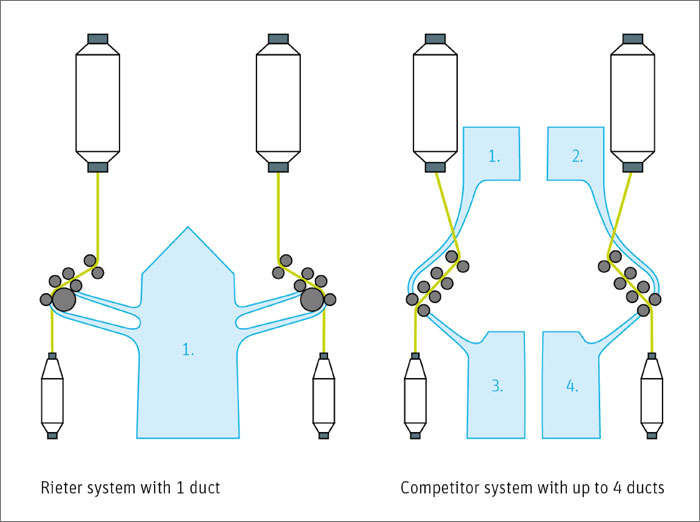
Textile Excellence
If you wish to Subscribe to Textile Excellence Print Edition, kindly fill in the below form and we shall get back to you with details.








